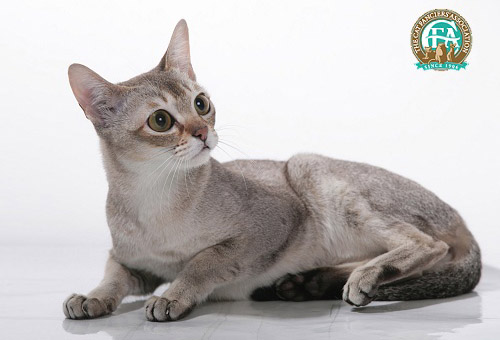


The Singapura's disposition is that of a "pesky people cat," an extroverted, curious, playful but nondestructive cat that insists on helping you with everything. They are very intelligent and interactive with people and remain so even into old age. Disposition is one of their most endearing attributes. If you want a cat geared to "four on the floor," don't consider owning a Singapura. The Singapura is a smaller than average, shorthaired cat with noticeably large eyes and ears. On first impression, you might think you were looking at some new color of Abyssinian. The pattern is nearly the same but on closer inspection you will note that the only other similarity is the large ears, everything else is different. The light beige coloring is unique and thought by some to be similar to cougars. The tail is normal length, the feet are very small, the body is smaller, of a medium length and should be muscular. Eyes may be hazel, green or yellow but mature eye color is not predicable in kittens. Many veterinarians seeing a Singapura for the first time are apt to think something might be wrong with the kitten since it is so small. The Singapura is slow to develop and will not attain its full size until about 15 to 24 months of age. There isn't much difference in size between mature males and females, females weighing approximately 5 to 6 pounds and males 6 to 8 pounds.
A pet quality cat will usually have cosmetic faults that make it unsuitable for showing or breeding. Some of the most common faults are head length (too long), eyes too close together, visible or non-visible tail faults, lack of complete nose-liner (the dark line around the nose leather), and markings on the outside of the front legs which should be clear of any markings. Additionally, only a limited number of male cats can be used in the breeding programs so only the best male kittens are retained for breeding. Regardless of the reason for a Singapura to be offered as a pet, you will find this cat's intelligence, playfulness and unique appearance captivating from the first time you meet one. Pricing on Singapuras usually depends on type, applicable markings and bloodlines distinguished by Grand Champion (GC), National Regional winning parentage (NW or RW) or of Distinguished Merit parentage (DM). The DM title is achieved by the dam (mother) having produced five CFA grand champion/premier (alter) or DM offspring, or sire (father) having produced fifteen CFA grand champion/premier or DM offspring. Usually breeders make kittens available between twelve and sixteen weeks of age. After twelve weeks, kittens have had their basic inoculations and developed the physical and social stability needed for a new environment, showing, or being transported by air. Keeping such a rare treasure indoors, neutering or spaying and providing acceptable surfaces (e.g. scratching posts) for the natural behavior of scratching (CFA disapproves of declawing or tendonectomy surgery) are essential elements for maintaining a healthy, long and joyful life. There are CFA clubs devoted to the promotion, protection and preservation of the Singapura breed. For more information, please send inquiries to CFA at cfa@cfa.org. Text: Nicki Ruetz Last Updated: Sunday, July 04, 2010
|
|||||